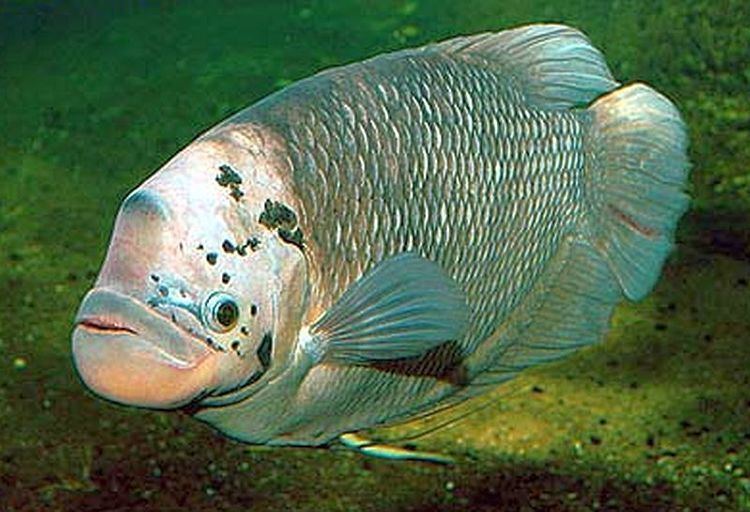Order Perciformes Genus Osphronemus Rank Species | ||
 | ||
Conservation status Least Concern (Population stable) Similar Clarias, Nile tilapia, Pangasius, Mozambique tilapia, Snapper | ||
My giant gourami albino pair
The giant gourami (Osphronemus goramy) is a species of large gourami native to Southeast Asia, with its occurrence in other locations due to introductions. They are native to Chao Phraya and Mekong basin in mainland Southeast Asia, and also rivers of Borneo, Java and Sumatra. This species is commercially important as a food fish and is also farmed. It can also be found in the aquarium trade. The species has also been used for weed control, as it can be a voracious herbivore.
Contents
- My giant gourami albino pair
- My 14 years old giant gourami
- Tank specifications
- Diet
- Breeding
- As food
- References

It lives in fresh or brackish water, particularly slow-moving areas such as swamps, lakes, and large rivers. It is capable of breathing moist air, so can survive out of water for long periods. It is much larger than most gouramis, growing to a maximum length of 70 cm (28 in), though most are only around 45 cm (18 in). In colour, it is a pale to golden yellow, with silvery, pale blue stripes running vertically along its body. Females can be identified by their thicker lips. Giant gouramis build nests using weeds and twigs.

My 14 years old giant gourami
Tank specifications

The giant gourami is also popular in aquaria. Preferably, the tank should have a dark bottom, and densely planted edges, with room left in the center of the tank for them to swim. They prefer the company of other fish of similar sizes and temperament. They are easy to keep at three months old at around 7.5 cm or 3 in long. At this age, they have a pronounced beak. They can grow rapidly given sufficient food and space to move. Even under less than ideal conditions, gourami can grow from 7.5 cm to 50 cm in four years. At this age, in addition to the rounded face, a mature giant gourami will have begun to develop the hump just above its eyes.

A gourami in a community tank will snap and charge any other fish which are small enough for it to bully. Like most aquarium dwellers, giant gourami can be quickly raised with larger, more passive fish. However, if other fish are added to a tank, either large or small, they might be killed within a short period.
Diet

Gourami tend towards herbivory, preferring algae-based foods, but will eat meaty foods. An algae-based flake food, along with freeze-dried bloodworms, tubifex, and brine shrimp, provides these fish with the proper nutrition while young. Once of significant size, they can be fed legumes, partially or fully cooked fibrous or starchy vegetables, or fruits.
Breeding
The giant gourami is an egg layer, and the male will build a bubble nest before spawning. The male and female are distinguished by the dorsal fins and body color. The dorsal fin on the male ends in a point, and the body is darker changing to nearly black during spawning. When breeding, the water in the tank should be decreased to about 20 cm (8 in) deep and the temperature should be 28 °C (82 °F). After spawning, the female should be removed to a separate tank as the male will jealously guard the eggs, in a captive environment, sometimes becoming aggressive towards the female. The eggs hatch in 24 hours. They must be kept in a dark aquarium.
As food
Partly in consequence of its size, the giant gourami is a significant food fish, and in its native regions it has been harvested as a customary food source. In Asian cuisine, gourami is highly valued as food due to its thick flesh, pleasant texture as well as its tasty flavour. Unlike carp and milkfish, gouramis do not have fine bones within their flesh, which render them easy to consume, thus elevate its economic value. In Southeast Asian market, gourami is one of the most highly-valued freshwater food fish. Gourami flesh is rich in protein and minerals.
It is a popular food fish in Indonesian, Malaysian and Thai cuisines. Gouramis are particularly popular in Sundanese cuisine of Indonesia, where they often being fried as ikan goreng, grilled as ikan bakar or cook with spice inside a banana leaf wrap as pepes. In some parts of Southeast Asia, they are being salted to preserve and prolong its shelf life.
